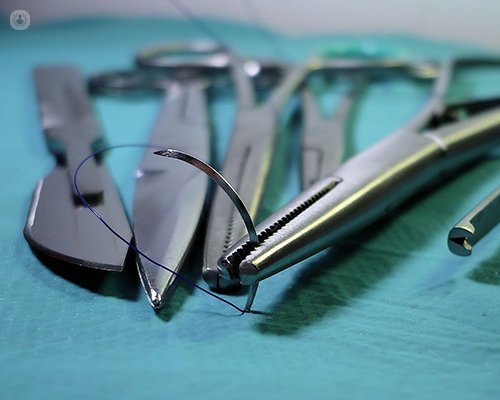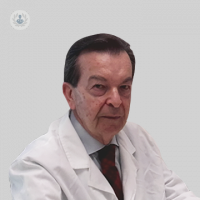Surgical treatment of esophageal cancer
Written by:
The main treatments for esophageal cancer are surgery, systemic (chemotherapy) and radiation therapy. In addition, the active palliation is an important part and including stenting, surgical shunts and support measures. The approach of esophageal cancer requires a multidisciplinary approach.
Currently, at the time of diagnosis only 30-40% of patients diagnosed with resectable disease considered (which can be removed in its entirety), achieving an R0 surgery (while tumor apparently in sight and touch) in the 70% of these cases.
Selection of candidates for surgical treatment
Proper selection of patients by the general surgeon can reduce the incidence of postoperative complications and mortality after surgery. Surgical resection should be considered in all patients with acceptable overall, in resectable tumors and located more than 5 cm below the cricopharyngeal muscle disease.
In patients potential candidates for curative treatment (surgery or reduction of tumor (neoadjuvant) followed by surgical treatment) is essential to the assessment of nutritional status, heart and lung function, renal function and liver function. Age itself is not an absolute contraindication although the age of 75 years as a measure for assessing this type of treatment is established. In certain cases with high risk indication is adjusted based on the surgical technique to be performed.
preoperative care
A key aspect is the preoperative respiratory function. The suppression of snuff and respiratory physiotherapy are two key factors to reduce postoperative respiratory complications.
Preoperative nutritional assessment is very important. Excessive weight loss, the number of low albumin, or the presence of certain risk factors are alarm criteria that indicate the need for nutritional recovery after surgical treatment.
According to the nutritional status and the possibility or not of oral feeding short preoperative supplementation between 5 to 7 days usually advised or 10 - 14 if malnutrition is severe, oral immuno or nasojejunal. If the intestinal function is not preserved, it is indicated nutrition intravenously.
Radical surgical treatment
Although esophageal tumors, may be adenocarcinomas or squamous, the therapeutic approach is similar for both types of tumors. The goal of surgery is complete resection of the disease and locoregional lymph nodes as well as the reconstruction of the digestive tract with minimal complications and sequelae.
The surgical technique varies according to the location of the tumor and patient comorbidities (transthoracic or transhiatal esophagectomy). Transthoracic esophagectomy technique and union in the thoracic or cervical dome allows better visualization of the surgical field and better removal of lymph nodes (lymphadenectomy). While the benefits, in terms of survival, are discussed regarding the transhiatal technique. The latter allows dissection of abdominal and cervical esophagus via a technically less extensive lymphadenectomy and cervical anastomosis. The ideal reconstruction of the digestive tract organ is the stomach tubulized. The colon or jejunum can be used in case of previous gastric surgery or concomitant gastric pathology. These surgical techniques today are made both open surgery (conventional) or minimally invasive approaches (laparoscopy or thoracoscopy). the technique you choose is chosen, it should be noted that changes in survival rates could be related to the increased incidence of adenocarcinoma and the use of surgery for treatment.
What are the risks involved?
Surgery of esophageal cancer is associated with a mortality to consider compared to other operations and hospital stays can be long. Postoperative mortality is occurring within 30 days after surgery.
Postoperative morbidity (incidence of complications) is important due to the characteristics of the disease, the patient, the possible effects of prior treatments with chemotherapy and radiotherapy and the inherent difficulty of the surgical procedure. Respiratory complications are the most frequent after esophagectomy and are related to preoperative factors (age, smoking, COPD, nutritional status), intraoperative (adequate management controls sera, duration of phase lock unipulmonar necessary to perform the operation) and postoperative (early extubation and respiratory physiotherapy). The most serious complication is spontaneous opening or failure of the esophageal junction (anastomosis), although the prognosis various factors such as the reason for the opening or the location of the union influence (depending on the type of interventions provided) and early appropriate treatment .
What kind of recommendations should follow the patient after surgery?
After these surgeries are common discomfort during meals. This is because the stomach, often formed into a tube, has moved upwards and attached to the small fragment remaining esophagus. This means that, after surgery, the stomach empty its contents slowly, as their contractions are ineffective to have been affected nerves that control. This can cause frequent nausea and vomiting.
In addition, after surgery the stomach contents can easily climb into the esophagus that is because the muscle that usually controls this (lower esophageal sphincter) often has been removed. This can cause symptoms such acidity. In these cases antacid medications can help relieve these symptoms.
Therefore it is advisable to not abundant but frequent meals, chewing food properly and eat slowly, keeping the head of the bed elevated, avoid alcohol and snuff and sometimes controls by a dietitian. It is important to explain to the patient, so do not be discouraged, it is likely that their quality of life is good and finished improve to 10 to 12 months after surgery, which may be fed properly and with few dietary restrictions.
Edited by Roser Berner Ubasos.


